
Welcome to Online Booking Portal for South Chennai Region
sorghum
சோம்பல் நீக்கும் சோளம்
Sorghum, (also known as Jowar) is the world’s fifth major cereal food crop in terms of production and acreage after rice, wheat, maize and barley. In India, the sorghum grains are used mainly for food while the stover after harvest of grains is highly valuable as nutritive fodder to animals. The grains are also used for poultry feed and has other industrial uses such as potable alcohol production. Sorghum scientifically known as C4 plant, is one of the most energy efficient crops in use of solar energy and water to produce food and biomass. The crop has inherent drought tolerant nature and can be grown under wide range of environmental conditions. In the semi-arid regions sorghum is a dual-purpose crop, as both grain and stover are highly valued for human and animal consumption, respectively.
 For bone health
For bone health
Calcium absorption, critical for bone health, is increased by magnesium. Compared to rice and wheat, sorghum contains higher levels of magnesium1.
 To defer age-onset degenerative diseases
To defer age-onset degenerative diseases
Sorghum is abundant in phenolic compounds and antioxidants2. Therefore, it has the potential for protection against age-onset degenerative diseases3.
 To keep diabetes at bay
To keep diabetes at bay
Sorghum has high resistant starch, which, in turn contributes to a low glycemic index and helps slow the absorption of carbohydrates, preventing extreme blood glucose fluctuations5, benefitting people with diabetes and obesity4.
Calcium absorption, critical for bone health, is increased by magnesium. Compared to rice and wheat, sorghum contains higher levels of magnesium1.
Sorghum is abundant in phenolic compounds and antioxidants2. Therefore, it has the potential for protection against age-onset degenerative diseases3.
Sorghum has high resistant starch, which, in turn contributes to a low glycemic index and helps slow the absorption of carbohydrates, preventing extreme blood glucose fluctuations5, benefitting people with diabetes and obesity4.
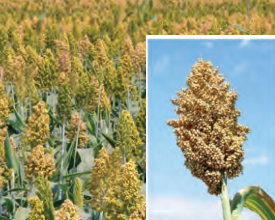
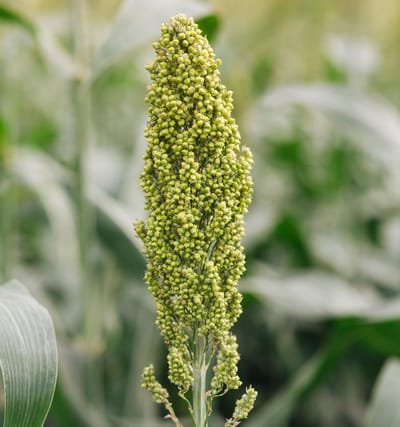
barnyard millet
குதிரை பலம் பெற குதிரைவாலி குதிரைவாலி தந்திடுமே குறைவில்லா வாழ்வு மூர்த்தி சிறியதானாலும் கீர்த்தி பெரியது
Barnyard millet is predominantly cultivated in India, China, Japan, and Korea for food as well as fodder. Japanese and Indian species of this millet are vigorous and have a wide adaptation in terms of soil and moisture requirements. They grow well in different seasons and at higher elevations, but require three to four months for maturation. It is cultivated on marginal lands where rice and other crops will not grow well. Barnyard millet is an erect plant 60-130 cm tall and spikelets are brownish to purple. It is grown for both grain and fodder in India especially in the hilly tracts of Uttarkhand, Eastern Asia and parts of Africa, and in the Eastern USA it has been a valuable forage crop. A relative, Australian millet (Echinocloa decompositum), is used by the aborigines of that continent as a cereal grain.
Click here for Recipes
Click here for Recipes
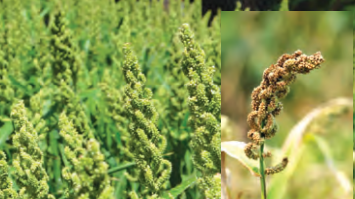
kodo millet(வரகு)
வரகு உண்டால் வருங்காலம் வரவு
Kodo millet is native to the tropical and sub-tropical regions of South America and domesticated in India 3,000 years ago. Kodo millet is extensively grown on the poorest of soils throughout India but is probably not cultivated to any extent elsewhere. It is reputed to be extremely hardy, drought resistant and grows on stony or gravelly soils which would not support other crops. It is relatively long in duration requiring four to six months to mature compared with two to four months for the other miIlets. Short duration varieties have now been developed. Kodo is an annual tufted grass that grows up to 90 cm high. The grain is enclosed in hard, corneous, persistent husks that are difficult to remove. The grain may vary in colour from light red to dark grey.
மதுரைக்காஞ்சி:(271-272)
“சிறுதினை கொய்ய கவ்வை கறுப்ப
கருங்கால் வரகின் இங்குரல் புலர“
Click here for Recipes
மதுரைக்காஞ்சி:(271-272)
“சிறுதினை கொய்ய கவ்வை கறுப்ப
கருங்கால் வரகின் இங்குரல் புலர“
Click here for Recipes
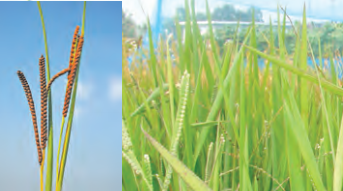
little millet(சாமை)
சாமை உண்டால் ஆமை வயது King of Sweets சாமான்யனின் சாப்பாடு – சாமை
Little millet was domesticated in the Eastern Ghats of India occupying a major portion of diet amongst the tribal people and spread to Sri Lanka, Nepal, and Myanmar. Little millet appears related to proso but is generally shorter, has smaller panicles and seeds, and is grown on a limited scale voluntarily or with minimum care on poor lands. Little millet matures quickly and withstands both drought and water logging. Less genetic diversity occurs in the world collections of this species than appears among the other species and the grains are similar to that of rice. Perhaps very little of this species is grown outside of India
Click here for recipes
Click here for recipes
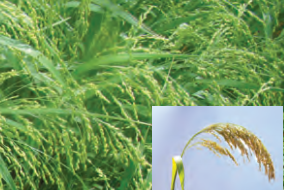
finger millet(கேழ்வரகு)
கேழ்வரகு சர்க்கரையே விலகு ராகியில் பலகாரம் கால்சியத்தின் அதிகாரம் ழகரத்தின் அடிப்படையில் பெயர்பெற்றது
Finger millet is an important primary food especially for the rural populations of Southern India and East & Central Africa. Finger millet or ragi can be grown under wide range of adaptation ie from sea level to hilly regions of Himalayas but thrives best under well drained, loamy type of soils. About 60% of finger millet is produced by the state of Karnataka which is about 34% of global production. Finger millet is a dwarf, highly tillering plant with characteristic finger like terminal inflorescences. The height of a mature plant ranges from 30-150 cm and the seeds are very small like mustard and are light brown, or dark brown or white in color. The crop matures in 3-5 months depending on the variety and growing conditions. The grains of finger millet are rich in quality protein having high amounts of tryptophan, cystine and methionine, fiber (10-15% dietary fiber), phytochemicals, calcium and other minerals
 Rich source of calcium
Rich source of calcium
Finger millet contains thrice the amount of calcium as milk1 and almost 8 times the amount found in other cereals. Bioavailability of calcium from meals prepared from finger millet is higher than from other wheat- and sorghum-based meals.
 Suitable weaning food for children
Suitable weaning food for children
The high levels of nutrients such as carbohydrates, proteins and calcium makes finger millet-based complementary foods appropriate weaning foods for babies.
Click here for Recipes
Finger millet contains thrice the amount of calcium as milk1 and almost 8 times the amount found in other cereals. Bioavailability of calcium from meals prepared from finger millet is higher than from other wheat- and sorghum-based meals.
The high levels of nutrients such as carbohydrates, proteins and calcium makes finger millet-based complementary foods appropriate weaning foods for babies.
Click here for Recipes
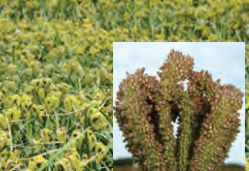
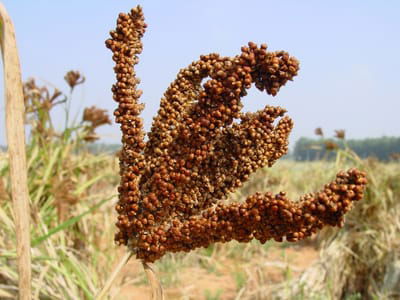
foxtail millet(தினை)
தினை இதயத்திற்கு துணை தினை உண்டால் தேக்கு போல் உடல் வலுவாகும் சங்ககால ‘ஏனல்’ – தினை
Foxtail millet is the third largest crop among the millets, cultivated for food in semi-arid tropics of Asia and as forage in Europe, North America, Australia, and North Africa. Foxtail or Italian millet may well have unrealized potential for grain production. It forms a slender, erect, leafy stem varying in height from 1-5 feet. Seeds are borne in a spike-like, compressed panicle resembling yellow foxtail, green foxtail, or giant foxtail. The grains are very similar to paddy rice in grain structure. They contain an outer husk, which needs to be removed in order to be used. The Chinese claim exceptionally high yields sometimes exceeding 11,000 kg per ha. It is drought - resistant, grows at higher elevations (up to 600 feet) and is frequently sown as an alternate crop with sorghum on black cotton soils when rainfall is deficient. It also grows well on loamy or alluvial and clayey soils. China grows most of the world’s crop, but some Italian millet is grown in India, Japan, and Russia. In the USA. it is largely sown for fodder.
Click here for Recipes
Click here for Recipes
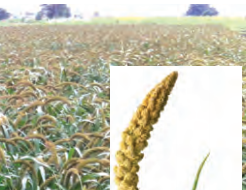
barnyard millet recipes
finger millet recipes
foxtail millet recpies
horsegram recipes
kodo millet recipes
little millet recipes
pearl millet recipes
mixed millet recipes
proso millet recipes
sorghum recipes
mappillai samba recipes
mixed-millet recipes
contact
- Navalur, Tamil Nadu, India
- Near to Navalur Bus Stop (Adjacent to Punjab & Sind Bank), Navalur, Chennai-600130
 +91-9488880099
+91-9488880099- +91-9488880099
- info@nilavoli.com
- 10:00AM to 17:00 PM